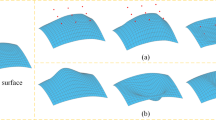Abstract
With the speed upgrade of the high-speed train, the aerodynamic drag becomes one of the key factors to restrain the train speed and energy saving. In order to reduce the aerodynamic drag of train head, a new parametric approach called local shape function (LSF) was adopted based on the free form surface deformation (FFD) method and a new efficient optimization method based on the response surface method (RSM) of GA-GRNN. The optimization results show that the parametric method can control the large deformation with a few design parameters, and can ensure the deformation zones smoothness and smooth transition of different deformation regions. With the same sample points for training, GA-GRNN performs better than GRNN to get the global optimal solution. As an example, the aerodynamic drag for a simplified shape with head + one carriage + tail train is reduced by 8.7%. The proposed optimization method is efficient for the engineering design of high-speed train.
Similar content being viewed by others
References
Raghuathan S, Kim H D, Setoguchi T. A Aerodynamics of high-speed railway train. Prog Aerosp Sci, 2002, 8: 469–514
Baker C. The flow around high speed trains. J Wind Eng Industr Aerodynam, 2010, 98: 277–298
Tian H Q. Formation mechanism of aerodynamic drag of high-speed train and some reduction measures. J Cent South Univ Technol, 2009, 16: 0166–0171
Tian H Q. Train Aerodynamics. Beijing: China Railway Publishing House, 2007. 160–161
Sun Z X, Song J J, An Y R. Optimization of the head shape of the CRH3 high speed train. Sci China Tech Sci, 2010, 12: 3356–3364
Jongsoo L J K. Approximate optimization of high-speed train nose shape for reducing micropressure wave. Industr Appl, 2008, 35: 79–87
Kwon H B, Jang K H, Kim Y S, et al. Nose shape optimization of high-speed train for minimization of tunnel sonic boom. Japan Soc Mech Eng, 2001, 4: 890–899
Ku Y C, Rho J H, Su H W, et al. Optimal cross-sectional area distribution of a high-speed train nose to minimize the tunnel micro-pressure wave. Struct Multid Optim, 2010, 42: 965–976
Lee S J, Kim B, Baik S W. Neural network modeling of inter-characteristics of silicon nitride film deposited by using a plasma-enhanced chemical vapor deposition. Expert Syst Appl, 2011, 38: 11437–11441
Kim B, Kwon M, Kwon S H. Modeling of plasma process data using a multi-parameterized generalized regression neural network. Microelectr Eng, 2009, 86: 63–67
Specht D F. A general regression neural network. IEEE T Neural Network, 1991, 2: 568–576
Leszek R. Generalized regression neural networks in time-varying environment. IEEE T Neural Network, 2004, 15: 576–596
Jamshid A S. Aerodynamic shape optimization based on free-form deformation. AIAA J, 2004. 2004–4630
Blazek J. Computational Fluid Dynamics Principles and Applications. New York: Elsevier Ltd., 2005. 16–17
Yan C. Method and Application of Computational Fluid Dynamics. Beijing: Beihang University Press, 2006. 236–237
Sobol I M, Shukman B V. Random and quasi-random sequences: Numerical estimates of uniformity of distribution. Math Comp Model, 1993, 18: 39–45
Donald R J. A taxonomy of global optimization methods based on response surfaces. J Global Optim, 2001, 21: 345–383
Author information
Authors and Affiliations
Corresponding author
Rights and permissions
About this article
Cite this article
Yao, S., Guo, D. & Yang, G. Three-dimensional aerodynamic optimization design of high-speed train nose based on GA-GRNN. Sci. China Technol. Sci. 55, 3118–3130 (2012). https://doi.org/10.1007/s11431-012-4934-2
Received:
Accepted:
Published:
Issue Date:
DOI: https://doi.org/10.1007/s11431-012-4934-2



